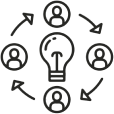Ability Prompt Cards Add/remove
Purpose:
There are three overall purposes when using the ability prompt cards:
- To identify abilities that might be affected by your design proposal.
- How does your design affect others – is it excluding or including?
- If it is excluding how can you then make them including.
Tips to include participants who are not able to:

See
For the post-its, make sure to have a partner that can do the writing. The participants should though still explain their own ideas to not feel excluded.

Think

Move
For the post-its, make sure to have a partner to spar with that can do the writing. This could be a helper, documenter, facilitator or other group members. The participants should though still explain their own input to not feel excluded.

Hold

Speak
Drawing ones ideas to further enhance communication is also possible.

Hear

Focus
Or, if you as a facilitator have been quick and analysed which ability cards that are maybe not accommodated by the participants solutions you could have chosen these ability cards prior to the method and only let them focus on those instead of all ability cards.

Belong
If the brainstorming is from the perspective of a persona that resembles a participant, don't let them be pointed out as that can make a person uncomfortable. Make sure the group is fairly diverse and representative.

Emote

Touch
Overview
Input
Concept proposals
Output
Evaluation on how inclusive/exclusive a concept proposal is.
Complexity
Moderate to complex
Time
10-30 min
Participants
2-15
Activity
Core abilities:
- Needs to be capable of reflection upon the concept proposal
- Needs to be capable of reflecting upon other examples of abilities given in the ability cards.
- Needs to be capable of addressing what abilities the concept proposal does not live up to and create changes so that it does live up to different abilities (require complex thinking)
Step by step:
Show the participants the ability cards and tell them that they consider both permanent, temporary and situational abilities.
Divide the participants in groups of 2-3.
The groups should go through the cards one by one and discuss if the concept proposal/ideas they have affects the abilities stated on the cards. Ask the groups to hold on to the cards that have abilities that are excluded in their design.
Ask the groups to go through the ability cards that their design excluded and make them discuss/brainstorm how to make the concept proposal more inclusive. Write changes to the solution on post-its – one post-it pr change.
Ask the participants to present their findings and new changes to their concept proposal.
When doing this method you should consider:
It is preferred that the groups of participants are formed based on the solution they have worked on. Do not switch up the groups if the different groups have worked with different solutions. It is a good idea to have the participants know the concept proposal really well before introducing the ability prompt cards.
More time might be needed if the concept proposals are complex and/or if it turns out that many changes have to be made in their designs.
If there is time it could be an idea to make the participants brainstorm about each ability card to let them expand their horizon of the ability before they compare their solution to the cards. This could open up their minds ensuring that they not only focus on the examples given on the ability cards but thinks beyond that. The examples on the ability cards are just examples, there are many more examples of each ability.
How the participants should brainstorm in this method is not specified but it would be preferred that you as a facilitator have determined a brainstorm method beforehand. You can either use brainstorming, brainwalking, negative brainstorming.
Materials needed:
A set of Ability Prompt Cards for each group
Pens
Post-its












